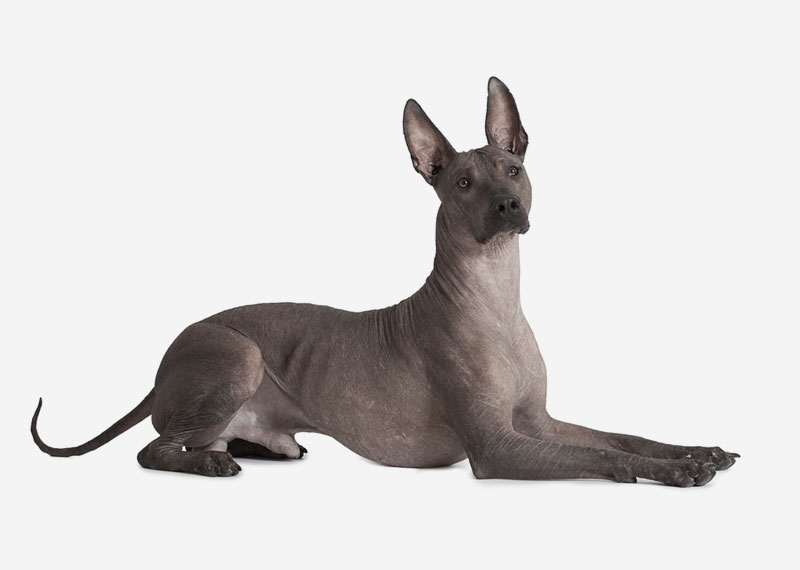The Xoloitzcuintle (/zoʊloʊ.iːtsˈkwiːntli/ ZOH-loh-eets-KWEENT-lee), or Xolo for short, is a hairless breed of dog, found in toy, miniature and standard sizes. It is also known as Mexican hairless dog in English speaking countries.
In Nahuatl, from which its English name originates, its name is xōlōitzcuintli [ʃoːloːit͡sˈkʷint͡ɬi] (singular) and xōlōitzcuintin [ʃoːloːit͡sˈkʷintin] (plural). The name xōlōitzcuintli comes from the god Xolotl and itzcuīntli [it͡skʷiːnt͡ɬi], meaning dog in Nahuatl.
A genetic study was recently conducted in order to determine the origin of the Xoloitzcuintli breed. The study did not find a close genetic relationship between Xoloitzcuintli and the Chinese Crested Dog. However, the study showed that this breed did not result from a separate domestication of dogs in the New World. Xoloitzcuintli appear to have been a result of a mixture of several Old World dog breeds.
Health
The Xolo has been developed by natural selection for thousands of years, and is therefore generally not prone to health and structure problems as other dog breeds more modified by human selection efforts. Xolos came from tropical climates and are not suited for outdoor life in colder temperate and northern climates; they should be considered an indoor dog breed. They need bathing, light grooming and skin care as with other dogs of similar physical type, or acne can result. Most skin problems arise from poor breeding, neglect, or over-bathing and over-lotioning, stripping natural protections and clogging pores.
- Nahuatl Dictionary. (1997). Wired Humanities Project. University of Oregon. Retrieved September 1, 2012
- C. Vilà, J.E. Maldonado, and R.K. Wayne. Phylogenetic relationships, evolution, and genetic diversity of the domestic dog Journal of Heredity (1999) 90(1): 71-77. doi:10.1093/jhered/90.1.71
- Xolo at Dog-breed-facts.com
- Coe, Sophie D. (1994) America's first cuisines ISBN 0-292-71159-X
- Aguilar-Moreno, M. (2006). Handbook to life in the Aztec world. Oxford University Press: USA. ISBN 978-0-19-533083-0
- "Mythical chupacabra found?". CNN. 1 September 2009. Retrieved 12 May 2010.
- National Xolo Rescue at the XCA website
- Xolo News at AKC.org
- "Inheritance and Breeding Results of Mexican Hairless Dogs", Laboratory Animals, 1993.
- "FCI-Standard N° 234: XOLOITZCUINTLE (Hairless Variety & Coated Variety)". Fédération Cynologique Internationale. 2011-02-16. Retrieved 2012-08-20.
- Xoloitzcuintli Club of America
- Drogemuller, C.; E. K. Karlsson, M. K. Hytonen, M. Perloski, G. Dolf, K. Sainio, H. Lohi, K. Lindblad-Toh, and T. Leeb. "A Mutation in Hairless Dogs Implicates FOXI3". Science 321 (5895):1462, 2008.
- Kimura, T; Doi, K. "Spontaneous Comedones on the Skin of Hairless Descendants of Mexican Hairless Dogs." Experimental Animals, 45(4), pp 377-384 1996
- Kimura, T. "Studies on Development of Hairless Descendants of Mexican Hairless Dogs and Their Uses in Dermatological Science." Experimental Animals, 45(1), pp 1-13 1996
In popular culture
101 Dalmatians II: Patch's London Adventure






